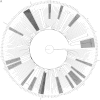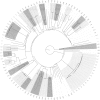Rapid and Easy In Silico Serotyping of Escherichia coli Isolates by Use of Whole-Genome Sequencing Data
- PMID: 25972421
- PMCID: PMC4508402
- DOI: 10.1128/JCM.00008-15
Rapid and Easy In Silico Serotyping of Escherichia coli Isolates by Use of Whole-Genome Sequencing Data
Abstract
Accurate and rapid typing of pathogens is essential for effective surveillance and outbreak detection. Conventional serotyping of Escherichia coli is a delicate, laborious, time-consuming, and expensive procedure. With whole-genome sequencing (WGS) becoming cheaper, it has vast potential in routine typing and surveillance. The aim of this study was to establish a valid and publicly available tool for WGS-based in silico serotyping of E. coli applicable for routine typing and surveillance. A FASTA database of specific O-antigen processing system genes for O typing and flagellin genes for H typing was created as a component of the publicly available Web tools hosted by the Center for Genomic Epidemiology (CGE) (www.genomicepidemiology.org). All E. coli isolates available with WGS data and conventional serotype information were subjected to WGS-based serotyping employing this specific SerotypeFinder CGE tool. SerotypeFinder was evaluated on 682 E. coli genomes, 108 of which were sequenced for this study, where both the whole genome and the serotype were available. In total, 601 and 509 isolates were included for O and H typing, respectively. The O-antigen genes wzx, wzy, wzm, and wzt and the flagellin genes fliC, flkA, fllA, flmA, and flnA were detected in 569 and 508 genome sequences, respectively. SerotypeFinder for WGS-based O and H typing predicted 560 of 569 O types and 504 of 508 H types, consistent with conventional serotyping. In combination with other available WGS typing tools, E. coli serotyping can be performed solely from WGS data, providing faster and cheaper typing than current routine procedures and making WGS typing a superior alternative to conventional typing strategies.
Copyright © 2015, American Society for Microbiology. All Rights Reserved.
Figures



Comment in
-
Whole-Genome Sequencing Data for Serotyping Escherichia coli-It's Time for a Change!J Clin Microbiol. 2015 Aug;53(8):2402-3. doi: 10.1128/JCM.01448-15. Epub 2015 Jun 17. J Clin Microbiol. 2015. PMID: 26085609 Free PMC article.
Similar articles
-
Whole-Genome Sequencing Data for Serotyping Escherichia coli-It's Time for a Change!J Clin Microbiol. 2015 Aug;53(8):2402-3. doi: 10.1128/JCM.01448-15. Epub 2015 Jun 17. J Clin Microbiol. 2015. PMID: 26085609 Free PMC article.
-
ECTyper: in silico Escherichia coli serotype and species prediction from raw and assembled whole-genome sequence data.Microb Genom. 2021 Dec;7(12):000728. doi: 10.1099/mgen.0.000728. Microb Genom. 2021. PMID: 34860150 Free PMC article.
-
Phenotypic H-Antigen Typing by Mass Spectrometry Combined with Genetic Typing of H Antigens, O Antigens, and Toxins by Whole-Genome Sequencing Enhances Identification of Escherichia coli Isolates.J Clin Microbiol. 2016 Aug;54(8):2162-8. doi: 10.1128/JCM.00422-16. Epub 2016 Jun 15. J Clin Microbiol. 2016. PMID: 27307455 Free PMC article.
-
[A complete view of the Escherichia coli O-antigen biosynthesis gene cluster and the development of molecular-based O-serogrouping methods].Nihon Saikingaku Zasshi. 2016;71(4):209-215. doi: 10.3412/jsb.71.209. Nihon Saikingaku Zasshi. 2016. PMID: 27980292 Review. Japanese.
-
Are Escherichia coli Pathotypes Still Relevant in the Era of Whole-Genome Sequencing?Front Cell Infect Microbiol. 2016 Nov 18;6:141. doi: 10.3389/fcimb.2016.00141. eCollection 2016. Front Cell Infect Microbiol. 2016. PMID: 27917373 Free PMC article. Review.
Cited by
-
First report and genomic characterization of Escherichia coli O111:H12 serotype from raw mussels in Türkiye.BMC Genomics. 2024 Nov 1;25(1):1027. doi: 10.1186/s12864-024-10945-4. BMC Genomics. 2024. PMID: 39487414 Free PMC article.
-
Comparative Genomic Analysis of Antimicrobial-Resistant Escherichia coli from South American Camelids in Central Germany.Microorganisms. 2022 Aug 24;10(9):1697. doi: 10.3390/microorganisms10091697. Microorganisms. 2022. PMID: 36144308 Free PMC article.
-
Comparative Genomics of Emerging Lineages and Mobile Resistomes of Contemporary Broiler Strains of Salmonella Infantis and E. coli.Front Microbiol. 2021 Feb 25;12:642125. doi: 10.3389/fmicb.2021.642125. eCollection 2021. Front Microbiol. 2021. PMID: 33717039 Free PMC article.
-
Genome characterization of a multi-drug resistant Escherichia coli strain, L1PEag1, isolated from commercial cape gooseberry fruits (Physalis peruviana L.).Front Microbiol. 2024 Jul 22;15:1392333. doi: 10.3389/fmicb.2024.1392333. eCollection 2024. Front Microbiol. 2024. PMID: 39104589 Free PMC article.
-
Comparative Analysis of Phylogenetic Relationships and Virulence Factor Characteristics between Extended-Spectrum β-Lactamase-Producing Escherichia coli Isolates Derived from Clinical Sites and Chicken Farms.Microbiol Spectr. 2022 Dec 21;10(6):e0255722. doi: 10.1128/spectrum.02557-22. Epub 2022 Nov 14. Microbiol Spectr. 2022. PMID: 36374015 Free PMC article.
References
-
- Kauffmann F. 1947. The serology of the E. coli group. J Immunol 57:71–100. - PubMed
-
- Ørskov F, Ørskov I. 1984. Serotyping of Escherichia coli. Methods Microbiol 14:43–112.
-
- Scheutz F, Cheasty T, Woodward D, Smith HR. 2004. Designation of O174 and O175 to temporary O groups OX3 and OX7, and six new E. coli O groups that include verocytotoxin-producing E. coli (VTEC): O176, O177, O178, O179, O180 and O181. APMIS 112:569–584. doi: 10.1111/j.1600-0463.2004.apm1120903.x. - DOI - PubMed
Publication types
MeSH terms
Substances
LinkOut - more resources
Full Text Sources
Other Literature Sources
Molecular Biology Databases
Miscellaneous

